Iron deficiency is the most common nutritional deficiency in the U.S., according to the Centers for Disease Control (CDC), with almost 10 percent of women being considered iron deficient! (1) Iron is an essential nutrient that helps up perform many functions throughout our body every single day. One of the most important functions? Iron helps to transport oxygen throughout the blood.
An iron deficiency is most commonly linked to the development of anemia, which is a condition when there’s a lack of healthy red blood cells being produced. Iron helps metabolize proteins and plays a role in the production of hemoglobin and red blood cells, helping to prevent anemia from forming.
According to the National Institutes of Health (NIH) National Heart, Lung, and Blood Institute:
“Iron-deficiency anemia is a common, easily treated condition that occurs if you don’t have enough iron in your body. Low iron levels usually are due to blood loss, poor diet, or an inability to absorb enough iron from food.” (2)
Iron Deficiency Signs and Symptoms
Iron is needed to produce hemoglobin, a type of protein found in red blood cells that has the role of carrying oxygen from your lungs and transporting it throughout your body to your cells. An iron deficiency can mean that you aren’t able to produce enough oxygen-carrying red blood cells − therefore your body struggles to transport oxygen to your brain, tissues, muscles and cells, leaving you feeling exhausted and weak.
Aside from preventing anemia, iron is a nutrient needed to maintain general well-being, energy and a healthy metabolism because it helps support overall cellular health and is involved in many enzyme functions. Iron plays a part in many enzyme reactions that help our bodies to digest foods and absorb nutrients. These reactions also balance hormone levels and support brain, heart, skin, hair, nail and metabolic health. (3)
Most of the 3–4 grams of elemental iron present within our body is in the form of hemoglobin. The remaining iron is stored in the liver, spleen and bone marrow, or is located in our muscle tissue’s myoglobin. (4)
An iron deficiency can lead to the following conditions:
- Anemia
- Chronic fatigue or low energy
- Pale or yellowing of the skin
- Shortness of breath
- Abnormal heartbeats
- Signs of a hormone imbalance
- Trouble exercising
- Muscle weakness
- Changes in appetite
- Trouble getting good sleep
- Changes in weight
- Cough
- Trouble concentrating, learning, remembering things
- Sores on your mouth or tongue
- Mood changes
- And basically any other normal symptoms of being very tired and fatigued
Women Need More to Prevent an Iron Deficiency Than Men Do
The amount of iron that someone needs daily in order to prevent an iron deficiency varies a lot depending on their age and gender. Women need more iron than men do because they lose a certain amount of iron during their normal menstrual cycle each month. (5)
Starting at around the time of adolescence when a woman begins having her menstrual cycle, her daily needs of iron increases, but then the level will decrease once again as the woman reaches menopause. Women who are between the ages of 19 to 50 need to get the most iron of any group − about 18 milligrams of iron each day. However, men of the same age can get away with having much less and will still be at a lower risk for having an iron deficiency. Men need just about 8 miligrams of iron daily. (6)
There are other risk factors that also put you at a higher risk for an iron deficiency. The most common reasons for an iron deficiency include:
- If you follow a vegetarian or vegan diet (which doesn’t include any animal sources of protein that are naturally high in iron)
- If you exercise a lot (which sometimes can damage red blood cells)
- If you’re pregnant or breastfeeding
- If you’ve ever had kidney failure
- If you’re undergoing, or have undergone, dialysis treatment, which can remove iron from the body
- If you’ve had ulcers in the past
- If you have any known gastrointestinal disorders that can limit your ability to absorb nutrients, such as celiac disease, Crohn’s disease or ulcerative colitis
- If you take a high amount of antacids, since these contain calcium that can prevent iron absorption
- If you’ve recently had surgery or lost blood for any reason, like donating blood
Luckily, an iron deficiency is usually pretty easy to identify with a simple blood test done at your doctor’s office, called a serum ferritin test. In fact, some people find out that they may have an iron deficiency when they attempt to donate blood at a blood donation center and the required screening test reveals that their iron levels are low. It’s recommended you get your blood checked on a regular basis to see if you need to increase your iron intake, especially if you’re pregnant, a vegetarian or have a digestive disorder.
Recommended Daily Amount of Iron (7)
- Children ages 4 to 8: 10 milligrams
- Children ages 9 to 13: 8 milligrams
- Women ages 19 to 50: 18 milligrams
- Pregnant women: 27 milligrams
- Lactating women: 10 milligrams
- Men ages 19 to 50: 8 milligrams
As you’ll notice, toddlers need more iron than children do because iron supports the process of growth and cognitive development. It can be hard for young children to get enough iron from their diet alone, especially if they are “picky eaters” — so having a blood test done during a toddler’s yearly check-up can identify an iron deficiency before it becomes a bigger problem.
According to the CDC, “iron deficiency is seen most often between six months and three years of age due to rapid growth and inadequate intake of dietary iron. Identify if iron supplementation might be needed.” Infants and children are at a heightened risk for iron deficiency if they’re born small or premature, are given cow’s milk before their first birthday, are formula-fed instead of breastfed, and if they consume more than 24 ounces of cow, goat or soy milk per day. (8)
Breast milk is believed to contain highly bioavailable iron, but in amounts that are not sufficient to meet the needs of infants older than 4–6 months. Therefore, the NIH recommends that babies begin to eat solid foods that are naturally rich in bioavailable iron, or to eat iron-fortified foods or formula as soon as they are able to.
Women who are pregnant also need more iron than the general population, so it’s recommended that they take iron as part of a pre-natal vitamin complex. Finally, anyone who has lost blood due to a recent surgery will also want to supplement with iron in order to prevent signs of an iron deficiency.
How You Can Prevent an Iron Deficiency
When it comes to getting enough absorbable iron from food sources, there are several things to consider:
- Animal foods contain a type of iron called heme iron, which is more absorbable than iron found in plant foods, called non-heme iron.
- When you eat different foods together, they can interact to either boost the body’s ability to absorb iron, or they can do the opposite and make it harder to absorb the iron present in the foods.
- The NIH estimates that Americans get about 10–15 percent of their iron intake from heme iron, while the rest comes from non-heme iron. Because non-heme iron is less absorbable, this may be one reason why iron deficiency is so common.
If you are a vegetarian or vegan, you’ll want to be careful about getting enough iron and may want to consider taking an iron supplement. This is because the type of iron found in plant foods is known to not be as absorbable as animal sources of iron are. Iron from meat, poultry and fish − heme iron − is absorbed two to three times more efficiently than iron from plants (non-heme iron) is absorbed.
The amount of iron absorbed in the body also depends on the other types of foods eaten at the same meal. Foods like meat or fish that contain the animal source of iron (heme-iron) enhance the body’s ability to absorb the type of iron present in plant foods (non-heme iron).
Iron can be found in plant foods such as spinach and beans, but when you eat these foods along with an animal source of iron, your body is able to use the iron better. Because foods containing vitamin C can also enhance non-heme iron absorption, this is another useful way for vegetarian and vegans to increase their iron stores.
There are also substances found naturally in some foods and drinks that decrease the body’s ability to absorb iron. Foods that contain chemical compounds like polyphenols, phytates, or calcium make it harder for the body to absorb and store iron. These can be found in such foods as tea, coffee, whole grains, legumes, nuts, seeds and dairy products.
According to the NIH, “the richest sources of heme iron in the diet include lean meat and seafood. Dietary sources of non-heme iron include nuts, beans, vegetables and fortified grain products. In the United States, about half of dietary iron comes from bread, cereal and other grain products.
Best Foods to Prevent Iron Deficiency
It may seem complicated to pair the right foods together in order to absorb iron in the best way, but if you eat a varied diet overall that includes plenty of whole foods, “the amount of iron inhibition from these substances is usually not of concern,” according to the Dietary Guidelines for Americans. (9)
So in general, try to eat a varied, whole-foods based diet that includes good sources of iron like grass-fed meat products, organic free-range poultry, cage-free eggs, organic (ideally unpasteurized) dairy products like raw milk, plenty of different fruits and vegetables, beans, and, on occasion, whole grains.
Also, try to eat foods in combinations that help your body to absorb iron better. For example, you can pair a food that is naturally high in vitamin C (like leafy greens or citrus fruits) with beans to make a better source of iron, since vitamin C helps your body absorb the non-heme iron.
You can include some of these high vitamin C foods — guava, red bell pepper, kiwi, oranges, grapefruits, green peppers, blueberries, all cruciferous vegetables like Brussel sprouts or broccoli, cantaloupe, and pea pods — in your meals in order to increase your absorption of iron.
Here are the 12 best food sources of naturally occurring iron that can help you prevent an iron deficiency (keep in mind that the RDA is very different for each person, with adult males needing 8 millifemA daily and adult females prior to menopause needing 18 milligrams):
- Liver (from beef) (10) — 4 ounces: 9.5 milligrams
- White beans (11) — 1 cup cooked: 6.6 milligrams
- Lentils (12) — 1 cup cooked: 6.5 milligrams
- Spinach (13) — 1 cup cooked: 6.4 milligrams
- Kidney beans (14) —1 cup cooked: 5.2 milligrams
- Chickpeas (15) — 1 cup cooked: 4.7milligrams
- Duck (16)— half of one breast: 3.7milligrams
- Sardines (17) — 1 can/3.75 ounces: 2.7 milligrams
- Grass Fed Beef (18) — 3 ounces: 2 milligrams
- Lamb (19) — 3 ounces: 1 milligrams
- Blackstrap molasses (20) — 1 tablespoon: 0.9 milligrams
- Pumpkin Seeds (21) — ¼ cup: 0.5 milligrams
Iron Health Benefits
1. Prevents Anemia
Anemia is caused by a low production of red blood cells and hemoglobin, therefore low oxygen reaches cells throughout the body. Anemia usually results in low energy levels but can also affect many parts of the body − from poor brain function to low immunity (or the inability to fight off illnesses). The World Health Organization (WHO) estimates that approximately half of the 1.62 billion cases of anemia worldwide are due to iron deficiency, while the other half are due to genetic factors. (22)
According to the Department of Human Health at Virginia Polytechnic Institute and State University, anemia develops when:
… individuals have inadequate iron intake, impaired absorption or transport, physiologic losses associated with chronological or reproductive age, or chronic blood loss secondary to disease. In adults, IDA can result in a wide variety of adverse outcomes including diminished work or exercise capacity, impaired thermoregulation, immune dysfunction, GI disturbances, and neurocognitive impairment. (23)
2. Supports Energy Levels
Iron supports ongoing energy by helping enough oxygen to reach cells. Iron also helps with the metabolic enzyme processes that the body carries out to digest proteins and absorb nutrients from food. This is why an iron deficiency causes exhaustion, trouble being active and many other symptoms of feeling sluggish.
Iron deficiency commonly shows up in symptoms like low concentration, mood changes and trouble with muscle coordination. Iron is needed for muscle movement because it helps store the oxygen in muscles that allows them to move and strengthen.
3. Helps Maintain Cognitive Function
Iron is needed for supporting brain function because it carries oxygen to the brain; in fact, about 20 percent of all of the oxygen in the body is used by the brain. Therefore, an iron deficiency can impair memory or other mental functions. In infants and children, a deficiency can cause psychomotor and cognitive abnormalities that have the potential to lead to learning difficulties.
4. Supports Development and Growth
Iron deficiency can delay normal motor function − meaning the ability to connect thoughts with activities and movement − as well as mental functions like learning and processing new information.
5. Needed for a Healthy Pregnancy
Iron deficiency during pregnancy increases the risk for a premature birth and also for the newborn being underweight. Sadly, premature born babies are known to have more health-related problems during their first years of life and may experience delayed growth and cognitive development.
All pregnant women are advised to eat plenty of iron-rich foods and to take supplements, because as the NIH warns,
“Insufficient iron intakes during pregnancy increase a woman’s risk of iron deficiency-caused anemia. Low intakes also increase her infant’s risk of low birth weight, premature birth, low iron stores, and impaired cognitive and behavioral development.” (24)
A study done by the Department of Nutrition for Health and Development, WHO found that taking iron supplements during pregnancy is associated with an 8.4 percent risk of having a low-birth weight newborn, compared to 10.2 percent risk when the mother does not supplement with iron. The average birth weight in the WHO study was 31 g. higher in infants whose mothers took daily iron supplements during pregnancy, compared to the weight of infants of mothers who did not take iron. (25)
6. Supports Immune System
Iron is needed to properly digest and absorb other nutrients from food, due to its role in metabolic enzyme processed. In addition, iron helps to bring enough oxygen to damaged areas of the body, including damaged tissues, organs and cells that are prone to infection or disease development.
7. Helps Maintain Positive Mood
Neurotransmitter functions that support a positive mood rely on adequate levels of iron within the blood. Your mood relies on a balance of hormones — including serotonin, dopamine and other vital hormones — that cannot properly be synthesized in the brain when oxygen levels are low.
This is one reason why iron deficiency results in a poor mood, bad sleep, low energy levels and a lack of motivation. If you notice changes in your mood and feelings of mild depression or anxiety, an iron deficiency could possibly be a contributor.
8. Prevents Restless Leg Syndrome
Iron deficiency is one of the causes of the restless leg syndrome, which can lead to major sleep disturbances. Iron helps to transport enough oxygen to muscles which decrease muscle spasms and pain.
Are Supplements the Answer for Treating an Iron Deficiency?
When someone has too much iron in their blood, this can also create problems. Iron overload is the accumulation of excess iron in body tissues and can cause a disorder called hemochromatosis. This is unlikely to happen from eating foods rich in iron alone. Instead, hemochromatosis is usually caused by either genetic causes or from taking iron supplements in high amounts.
High doses of supplemental iron (45 milligrams/day or more) can also cause side effects including nausea, vomiting, cramps and constipation, but iron in moderate amounts is thought to be well tolerated and shouldn’t cause many adverse reactions.
Keep in mind that iron can interact with other nutrients including calcium. Some studies show that calcium might interfere with the absorption of iron, although this effect has not been definitively established. Still experts suggest that people taking calcium and iron supplements should do so separately, spaced throughout the day, in order for both to be most beneficial.
In people who have taken medications for Parkinson’s disease, cancer or heart disease, the medications may be malabsorbed when also taking iron supplements. As a result, these people will want to speak with their doctor before taking any iron supplements on their own.
Recipes to Naturally Help Prevent Iron Deficiency
To help increase your intake of iron naturally, try adding foods that high in iron into your diet in some of these ways:
- Have a spinach salad topped with Tangy Bean Salad
- Try making some split pea soup or a bean-based chili or soup
- Have an Avocado Bison Burger or make your own veggie burger topped with homemade hummus
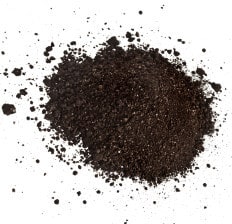
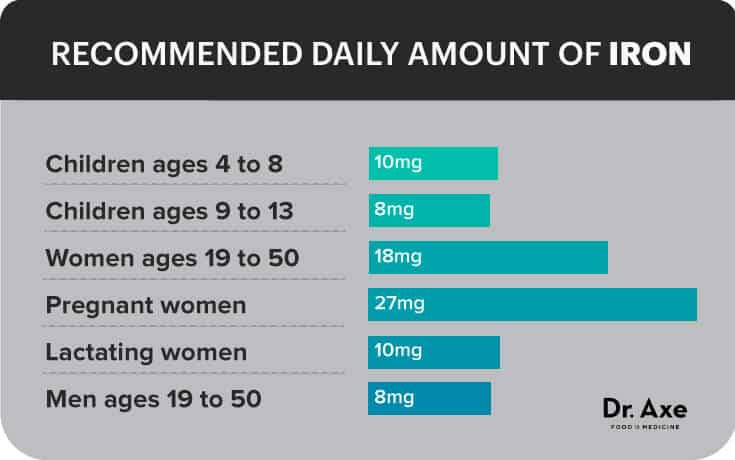
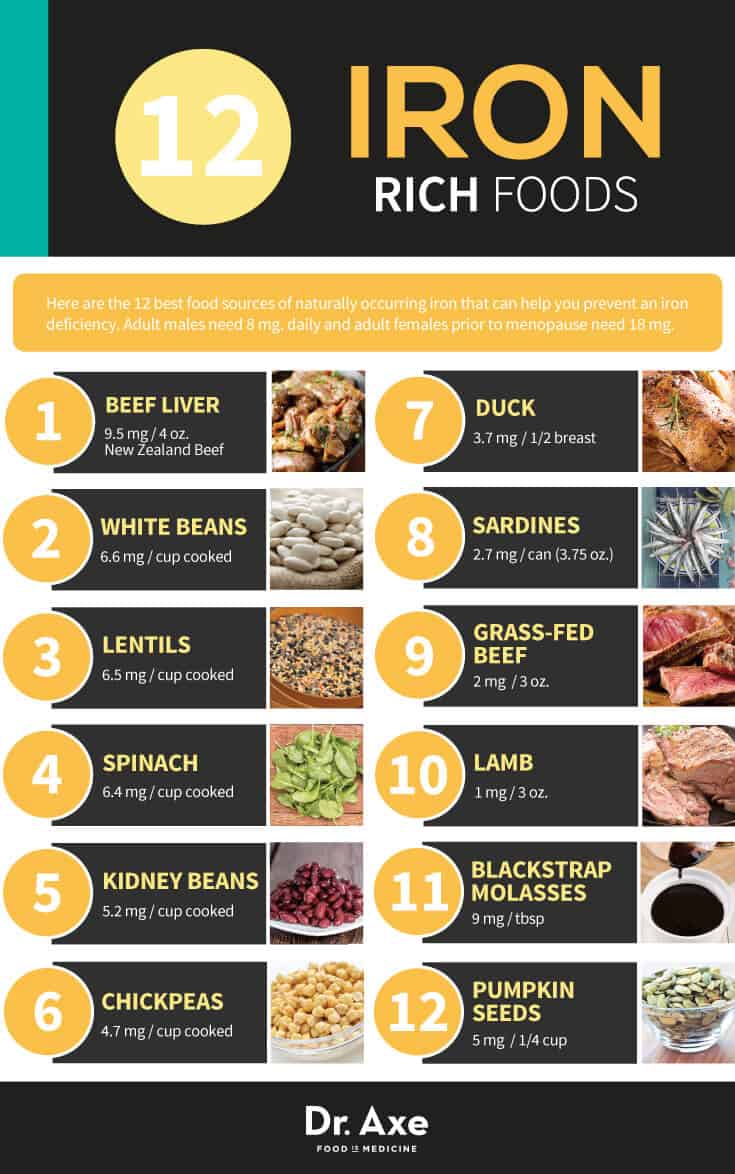


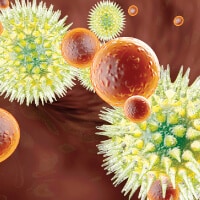
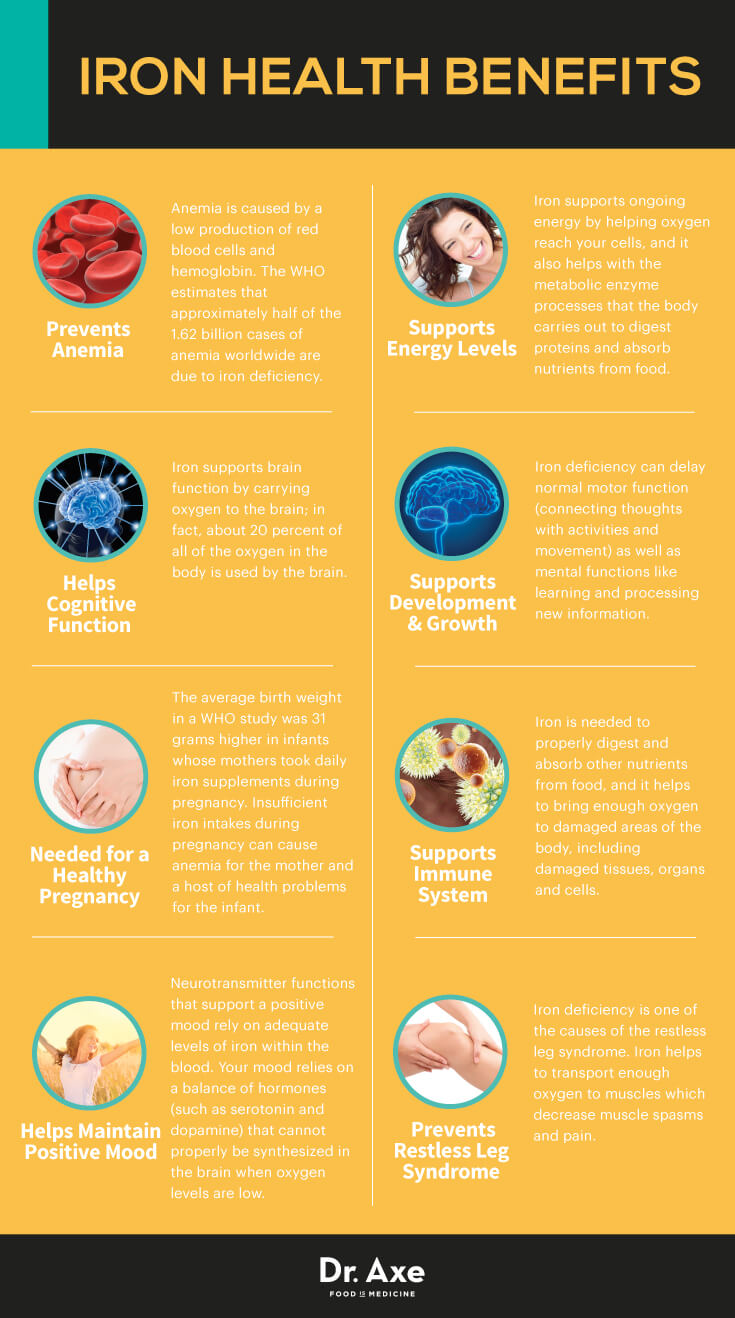
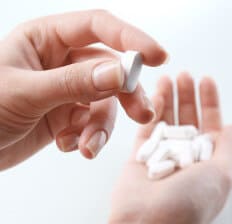
No comments:
Post a Comment